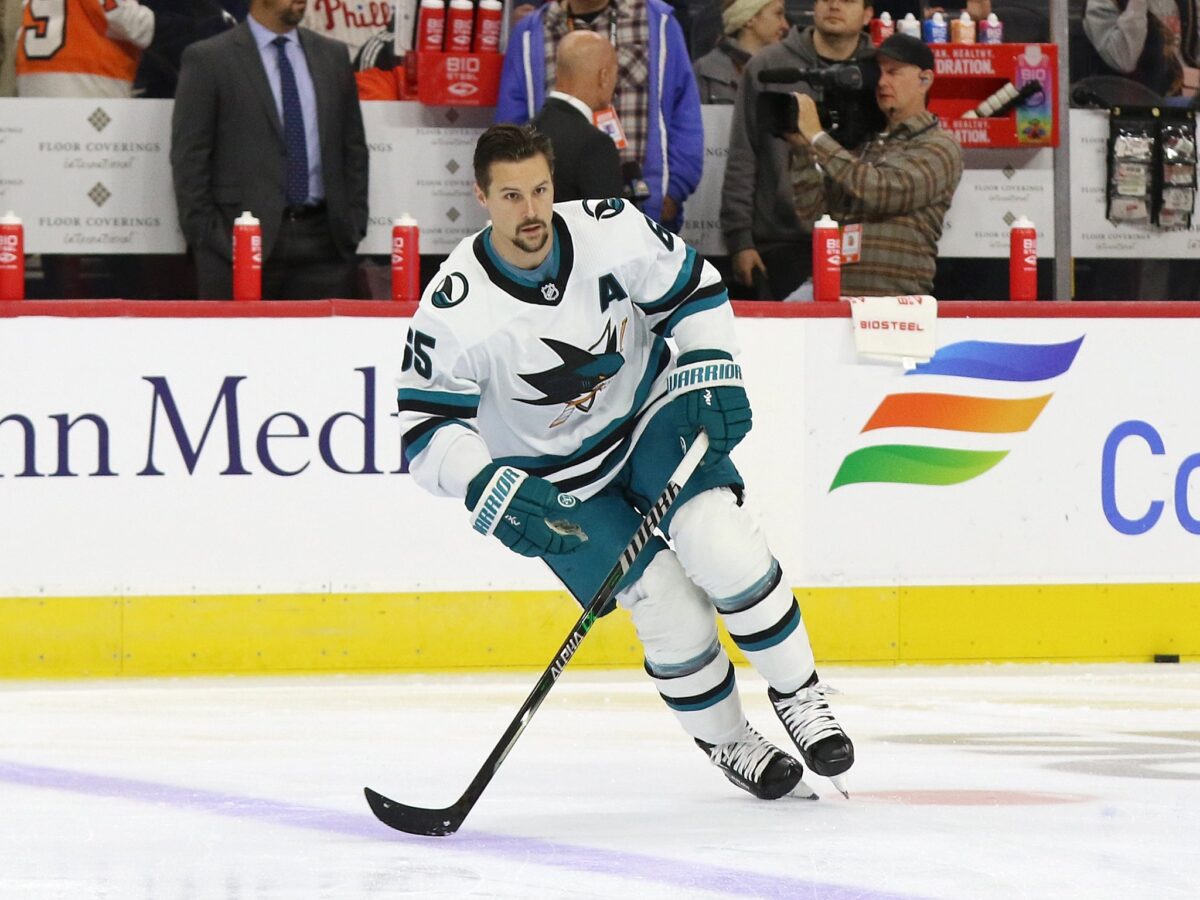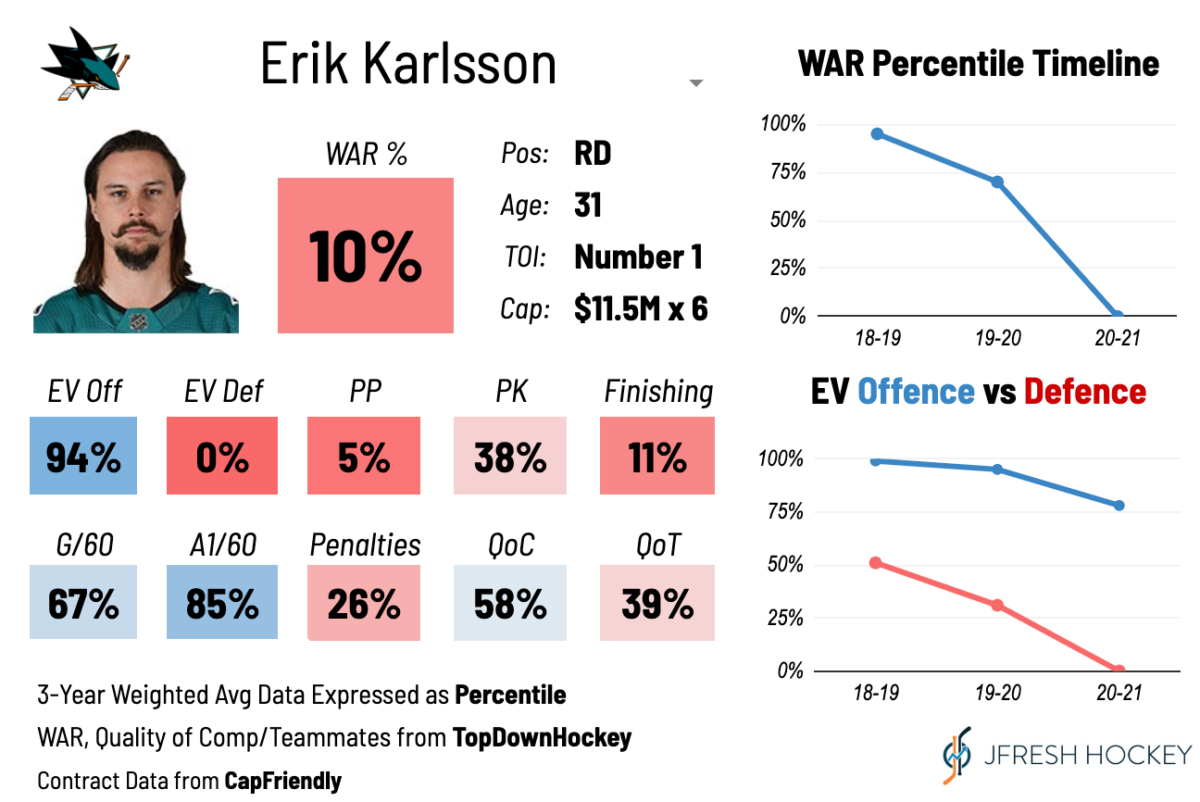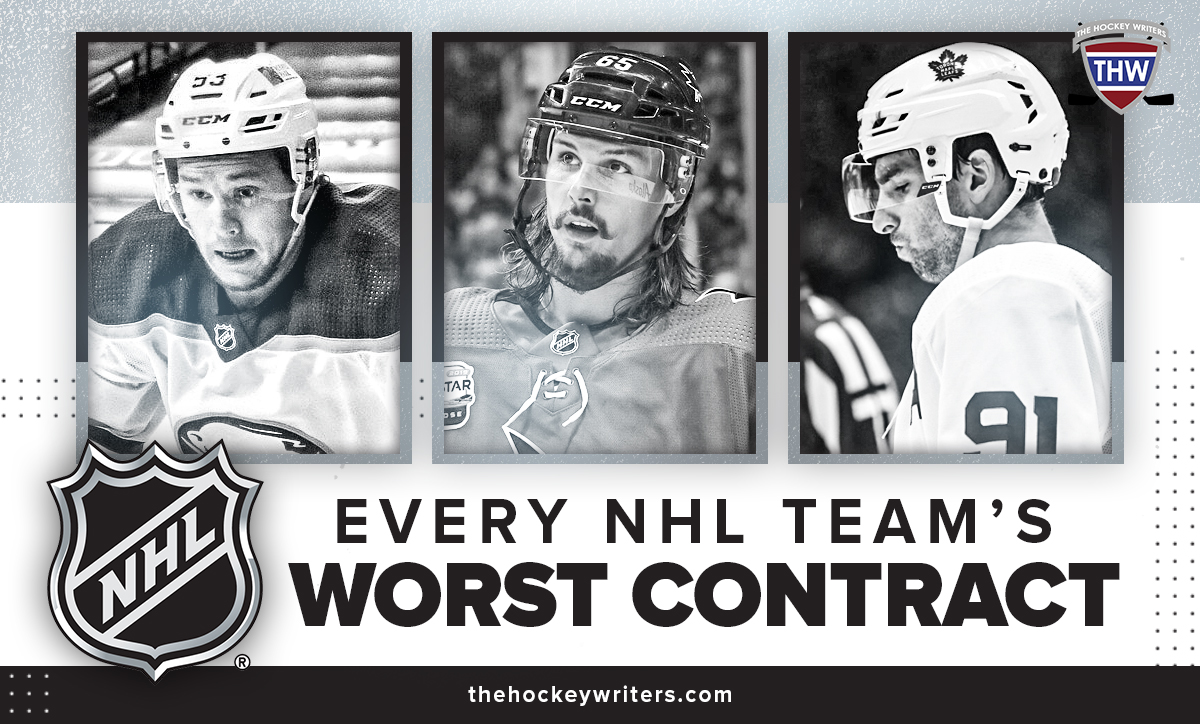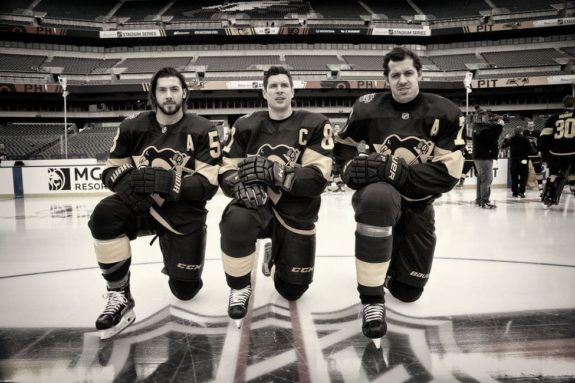For the past week or so, the rumour mill has run rampant with the idea of Erik Karlsson being traded from San Jose. One of the two teams featured in those rumours is the Pittsburgh Penguins.
On Thursday in The Athletic, Penguins beat writer Josh Yohe authored an article entitled “Eric Karlsson is precisely what the Penguins could use” (from ‘Eric Karlsson is precisely what the Penguins could use’, The Athletic, July 6, 2023).

This piece will serve as a counter to that article. Regardless of whether I think Pittsburgh should acquire Karlsson, there is always room for both sides of discourse. I’ll get one point out of the way immediately: Josh Yohe is a quality writer, and more importantly, if you read his work, you know that he is a devoted father who clearly cares about his family. The fact that I’m choosing to write a piece countering his article is meant as a sign of respect for his work, as much as wanting to show the other side of this topic’s proverbial coin.
Hockey Ops by Twitter
The article begins by noting that in an informal Twitter poll conducted by the author, 80 percent of the nearly 12,000 Penguins fans who voted said that they would like to see Pittsburgh acquire Karlsson. Clearly, these are fans who still believe in the Jim Rutherford method of building a team. Why shouldn’t they? Rutherford oversaw two Stanley Cup-winning teams in Pittsburgh. While I’m all for Rutherford-level chaos (the man likes himself a good trade), Karlsson is a risky acquisition for multiple reasons.
In a vacuum, the idea that Karlsson makes Pittsburgh a better team, both in general and when compared to the presence of Jeff Petry on the roster (as is done in the article), is correct. That said, since when did hockey exist in a vacuum? The point is clear though: for Karlsson to come to Pittsburgh, both Petry’s cap hit, and roster spot need to be opened to fit Karlsson onto the team.
Related: Roster Rebuild: Penguins Can Contend With the Right Moves
As noted in my column last week about how I would have managed the beginning of Pittsburgh’s offseason, Petry has a modified no-trade/move clause where he can submit 15 teams he will not play for. This greatly limits what they can do with him. Why I had them sending Petry to the Detroit Red Wings last week was because he was born in nearby Ann Arbor, and the idea of going to his home state’s team and playing with a group that’s on the verge of making the playoffs could have great potential appeal. The Red Wings, who are still more than $13.5 million under the salary cap, could easily fit Petry’s $6.25 million cap hit on their roster today.
Why it likely doesn’t work now is that the Red Wings have seven defensemen on NHL deals, five of whom are capable of playing the right side like Petry. The Penguins also have no salary cap room and no reason to be willing to take back someone like Ben Chiarot. His effectiveness is declining and the three years at $4.75 million per season remaining on his deal isn’t appealing, not to mention his modified no-trade clause (10-team no-trade list). In all likelihood, the Red Wings are off the table, and a legitimate potential home for Petry and his contract is now gone.
Pittsburgh, a Suburb of Los Angeles
The article brushes past the difficulty in trading Petry and then waxes nostalgic about the number of superstar hockey players the Penguins have been graced with. Having superstars on the team is simply part of their DNA; Yohe then goes on to note how because of its history of stars, Pittsburgh is akin to the LA Lakers or Harlem Globetrotters of hockey. This is yet another reason listed in the article to trade for Karlsson. I can’t stress this enough: this is not how (good) professional sports teams are run. Teams don’t decide to trade for the Karlssons of the world because Paul Coffey once played there. Also, while not about Karlsson, I do have to ask, does anyone outside of Pittsburgh think of the Penguins like this?
Next, the article notes that Karlsson, because of his playing style, skill set, and superstar status, is made to be a Penguin. That’s easy to say, but again, when you’re sitting in a boardroom with your management team deciding if a player is made to be a Penguin — or a Boston Bruin, or a Philadelphia Flyer, etc. — regardless of whether they seem like a natural fit, it doesn’t often work out that said natural fit ends up playing for the team. This is far more romantic than it is pragmatic. Not every team has that easy-to-see identity based on their history, and there are only so many players that fit any of those identities to go around.
Again, the romanticism of Karlsson being born to be a Penguin does not solve yet another of the ex-general manager Ron Hextall-borne issues of how to remove Petry from the roster. Not to mention, this type of thinking comes from people living in the past as opposed to looking at what their team needs now. In Philadelphia, Garnet Hathaway might play like what the Flyers want their identity to be, but he will not be useful as far as helping them win a Stanley Cup, getting close over the duration of his contract, or turning players currently on that team into Bobby Clarke or Dave “The Hammer” Schultz.
Problems Never Age Well
At this point in the article, a pair of concerns around Karlsson are both noted and then negated. The two concerns mentioned are his age, and the fact that he is not known as a defensive stalwart. Let’s begin with those two.

The above shows where Karlsson was just two years ago: a completely one-dimensional player who had absolutely fallen off a cliff defensively. He is now 33 years old and coming off his first either good or great season since severely injuring his left ankle in 2017. That’s six seasons. And, yes, there is a difference between putting up points and playing at the level you’re capable of. It’s been that long since we saw Norris Trophy, Hall of Fame-level play from Karlsson.
Same as was noted with Jeff Carter last week; the older you get, you are not going to become more athletic. Your ankle is also not likely to stop aging and stop affecting you negatively. This is especially true with Karlsson, who does not have half of the bone in his left ankle. So, yes, his age matters, because with four more years on his contract, any year that Pittsburgh has the Karlsson who was playing the few years before this past season will be a year that Pittsburgh *regrets having traded for Karlsson (* denotes not regretting any trade if they win a Stanley Cup with Karlsson first).
Next, let’s talk about that defensive play. Here is where I will actually stick up for the Karlsson of this past season. Analytics did not love his defensive play this year, though they did not hate him either. As we saw with someone like Vladislav Gavrikov in Columbus, it is not easy for analytics to decipher who is part of the problem on a losing team. During his final season with the Blue Jackets in 2022-23, the analytics clearly showed that he was part of the problem. However, we saw that once he was on a different team with more depth and better structure in Los Angeles, he was indeed part of the solution. Last season in San Jose, from a purely defensive standpoint, Karlsson was not part of the problem. Add in his ability to either make a quick outlet pass up the ice or break the puck out of the zone himself, and it could be said that Karlsson was a strong net positive in his own zone last season. Keywords: last season.

The age issue affects every part of this trade concept. Going into his age-34 season, Karlsson’s contract will only age worse, as will his defense as his body is likely to further break down. At the end of this past season, Pittsburgh had the oldest team in the NHL by average player age at just over 30 years old per player. While Petry is going into his age-36 season, this does not tangibly make Pittsburgh any younger or solve that issue.
Karlsson Does Not Play Well With Others
Does this iteration of head coach Mike Sullivan’s Penguins play a defensive system that Karlsson can thrive in? On one hand, as he ages, he simply will not be as good defensively. With that said, it stands to reason that he could play in Sullivan’s system, as Kris Letang has shown himself to be a borderline Hall of Famer playing a similar style in this system. This brings up another negative that was not in the article and should have been. The Penguins already have Letang as its offensive architect from the blue line. Why do they need Karlsson, and why would they want two players who play such a similar style at both ends of the ice?
Historically, when Karlsson has had to share the right side of the blue line on the same team with another top offensive player, his play has plummeted (see Brent Burns in San Jose). What is it about Sullivan’s system that makes anyone think that Karlsson and Letang can dominate the 45-50 minutes per night they would collectively have on the ice each night and share the blue line effectively? Yes, during 5-on-5 play it will be much easier, as one can run with the Sidney Crosby unit and one can run with the Evgeni Malkin unit.
When it comes to the first power-play unit though, only one will get that spot, which drives a lot of the team’s goals and individual points. Human emotions will get involved and feelings will be hurt when only one of them ends up on the first power-play unit. How do you take Letang off the first power play, when he has spent his entire career there and won three Stanley Cups as their power-play quarterback? By the same token, how do you keep Karlsson off of that first power-play unit, when he not only just had the best offensive season by any defenceman in a generation, and is also the best offensive defenseman of this generation?

The clean and fairy tale answer is that someone will sacrifice for someone else, which is all well and good in theory, but in sports it does not work more often than not. Human beings have feelings, feelings get hurt, and no, money does not make them feel better and function as a reason to make everything fine. This type of issue can tear apart a locker room, which is the last thing that a team whose core has as strong of a bond as Crosby, Malkin, and Letang have would ever be looking for.
Pittsburgh’s Reality Isn’t Always a California Dream
Yohe’s article summarizes the issue by admitting that yes, the acquisition of Karlsson would be a risk; however, that’s okay as some risks are meant to be taken. Why is this the risk that’s worth taking, though, when you would be adding a redundant player with a considerable injury history, with four more years at a large cap hit regardless of what the cap is moving forward?
The risk they should have taken was to call Bill Guerin in Minnesota and ask him what the price would be for Jonas Brodin, arguably the best defensive defenseman in the NHL today, and who makes slightly less than Petry. That is the type of player Pittsburgh needs on their blue line, and no, the Penguins did not solve their issues by signing Ryan Graves. He is an Adam Larsson-type player (still can’t believe the trade was 1-for-1), a second-pair defensive defenseman who brings no discernible offensive skills to the table in any zone. Should Graves have a bad season defensively, he is suddenly not useful at all.
So, yes, lovers of chaos would greatly enjoy a Karlsson trade; what it would take to put together one, what the end result of it looks like, and what the on-ice product could become would all be incredibly fascinating both immediately and for historical purposes. However, with all respect to Josh Yohe, for what this version of the Penguins needs both now and in the future, quite simply, is not Karlsson.
